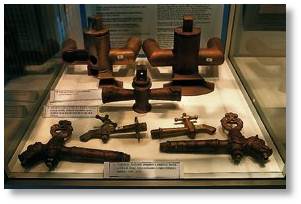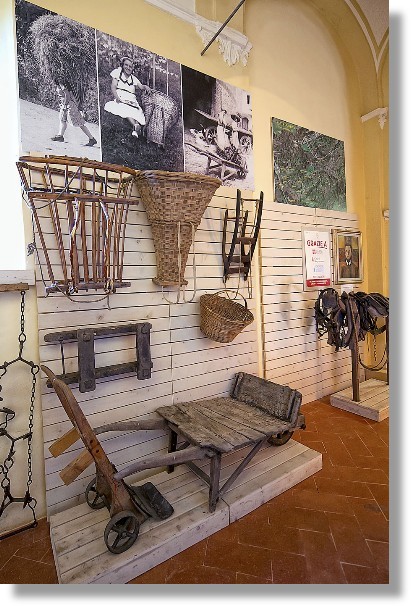|
Santa Cristina: Ethnographic Museum
The ethnographic museum in Santa Cristina - Borgomanero aims to protect and show many objects collected by local enthusiasts.
The collection is organized in a wide corridor and five rooms where there is a reconstruction of the typical rural setting. In the kitchen and in the bedroom are,
together with the furniture, also clothes and furnishings from last century.
We can admire vintage photos and work tools, from farming to the many different activities.
We can also visit a cellar in which we can learn the different phases of vinification through panels and explanations by friendly guides who are there just for passion
and love for their area.
Open: first Sunday of the month

Armeno: Museum of Hospitality
This museum has a unique collection of memoirs, fragments of life, testimonies, preserved over the years by
hoteliers, waiters and cooks around the world, kept as evidence of their activities. Armeno is famous for being
the home of the hoteliers, not only that, a historical legend tells that this town learnt the art of "managing of the
house" and "table serving" the Lombard nobles who, in order to escape the plague that broke out in the 17th century,
moved to Armeno.
In the museum you can see items of work such as, kitchen tools, photographs, collections of vintage
newspapers, menus of famous meetings, books and rare books of recipes along with many other documents that make this
place an authentic jewel of originality and suggestiveness.
Open: July and August
|

Gignese: The Umbrella and Parasol Museum
The Gignese Museum is the only one in the world devoted to umbrellas and parasols; its collection comprises over a thousand examples of umbrellas, parasols and handles.
Some items are curiosities, or of considerable historical and cultural importance, like the umbrellas that belonged to Queen Margherita of Savoy or the Risorgimento patriot and politician
Giuseppe Mazzini. The showcases display finely made and exquisitely decorated umbrellas, which visitors will find intriguing and ravishingly pretty. The section devoted to the life of the
umbrella-makers includes photographs of pioneer craftsmen, rudimentary tools from workshops of the past, and the tools that the umbrella makers/menders used when they plied their trade in
the streets of Italy and throughout the world.
The Museum takes us on a journey through a corner of history, full of images and memorabilia of an ancient trade that the local umbrella makers took successfully all over the world.
Open from April to September
|

Sesto Calende: The Archaeological Museum
The museum collection includes objects and archaeological finds, especially grave goods from ancient Etruscan tombs, all arranged in chronological order. These findings
especially occurred in the 1960s, the years of the most significant excavations in the area between Sesto Calende, Golasecca, and Castelletto sopra Ticino.
The collection starts with very simple, linear vases, cups, and urns and continues with a production of more sophisticated, rich grave goods representing the evolution
of the Culture of Golasecca in its various phases from the 9th to the 5th centuries BC. In addition to evidence of domestic activities, there are products for hygiene,
clothing, and the most attractive piece for visitors, the Tomb of the Tripod, which is a female sepulchre discovered in 1977, whose
grave goods were still in good condition.
The museum also has finds preceding the Culture of Golasecca and belonging to the Bronze Age, and also later material from the early centuries BC (tomb from the Gallic
period) to the Middle Ages (decorated slabs from the Abbey of San Donato).
|
San Maurizio d'Opaglio: The Tap Museum
The Tap Museum, with its unique exhibits, does not only trace the history of San Maurizio d'Opaglio and surrounding
district, famous for and specialised in the manufacture of taps and valves but, above all, displays the many themes relating to the
purifying of water and the use of water sources which the technology of the tap has always had to face.
The Museum chronicles the social history of water and the innovations which allowed to dominate it, transforming the cure of
the body from an élite practice into a mass phenomenon.
Reconstructing the history of the tap and fittings industry in the Novara area means reconstructing the social and industrial
history of Italy in the post-unification era.
|
copyright © 2023 Lucia De Zuani - All rights reserved - P.Iva 02329910034 - Privacy
| |






